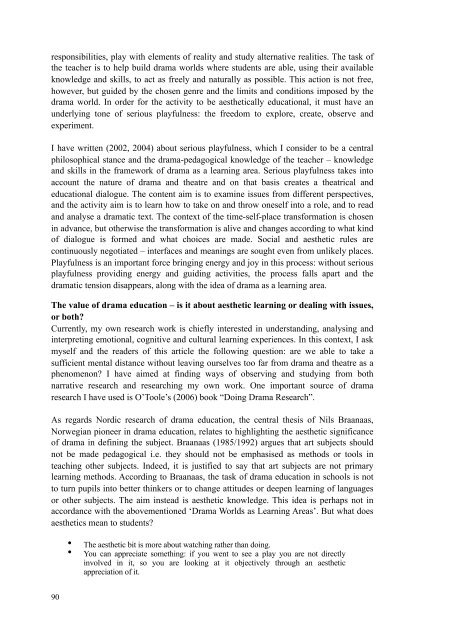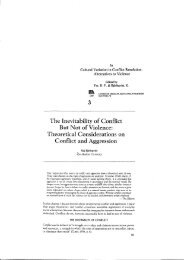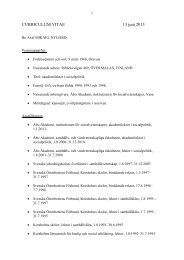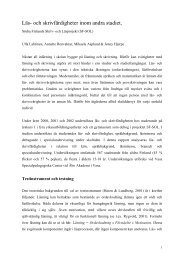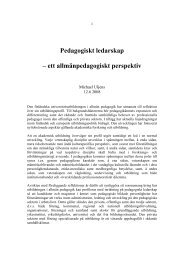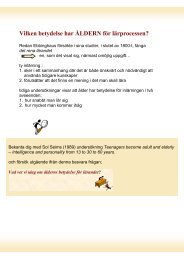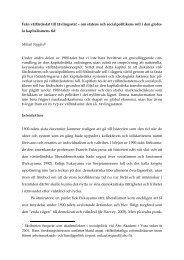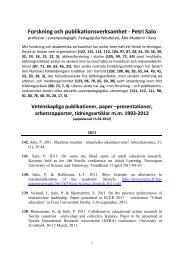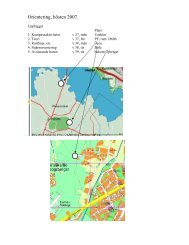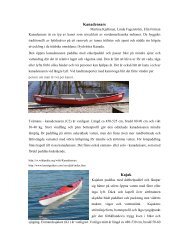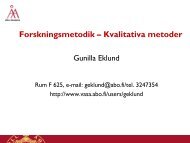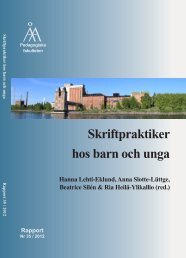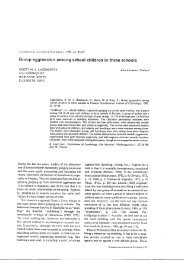Drama Boreale - Åbo Akademi
Drama Boreale - Åbo Akademi
Drama Boreale - Åbo Akademi
Create successful ePaper yourself
Turn your PDF publications into a flip-book with our unique Google optimized e-Paper software.
esponsibilities, play with elements of reality and study alternative realities. The task of<br />
the teacher is to help build drama worlds where students are able, using their available<br />
knowledge and skills, to act as freely and naturally as possible. This action is not free,<br />
however, but guided by the chosen genre and the limits and conditions imposed by the<br />
drama world. In order for the activity to be aesthetically educational, it must have an<br />
underlying tone of serious playfulness: the freedom to explore, create, observe and<br />
experiment.<br />
I have written (2002, 2004) about serious playfulness, which I consider to be a central<br />
philosophical stance and the drama-pedagogical knowledge of the teacher – knowledge<br />
and skills in the framework of drama as a learning area. Serious playfulness takes into<br />
account the nature of drama and theatre and on that basis creates a theatrical and<br />
educational dialogue. The content aim is to examine issues from different perspectives,<br />
and the activity aim is to learn how to take on and throw oneself into a role, and to read<br />
and analyse a dramatic text. The context of the time-self-place transformation is chosen<br />
in advance, but otherwise the transformation is alive and changes according to what kind<br />
of dialogue is formed and what choices are made. Social and aesthetic rules are<br />
continuously negotiated – interfaces and meanings are sought even from unlikely places.<br />
Playfulness is an important force bringing energy and joy in this process: without serious<br />
playfulness providing energy and guiding activities, the process falls apart and the<br />
dramatic tension disappears, along with the idea of drama as a learning area.<br />
The value of drama education – is it about aesthetic learning or dealing with issues,<br />
or both?<br />
Currently, my own research work is chiefly interested in understanding, analysing and<br />
interpreting emotional, cognitive and cultural learning experiences. In this context, I ask<br />
myself and the readers of this article the following question: are we able to take a<br />
sufficient mental distance without leaving ourselves too far from drama and theatre as a<br />
phenomenon? I have aimed at finding ways of observing and studying from both<br />
narrative research and researching my own work. One important source of drama<br />
research I have used is O’Toole’s (2006) book “Doing <strong>Drama</strong> Research”.<br />
As regards Nordic research of drama education, the central thesis of Nils Braanaas,<br />
Norwegian pioneer in drama education, relates to highlighting the aesthetic significance<br />
of drama in defining the subject. Braanaas (1985/1992) argues that art subjects should<br />
not be made pedagogical i.e. they should not be emphasised as methods or tools in<br />
teaching other subjects. Indeed, it is justified to say that art subjects are not primary<br />
learning methods. According to Braanaas, the task of drama education in schools is not<br />
to turn pupils into better thinkers or to change attitudes or deepen learning of languages<br />
or other subjects. The aim instead is aesthetic knowledge. This idea is perhaps not in<br />
accordance with the abovementioned ‘<strong>Drama</strong> Worlds as Learning Areas’. But what does<br />
aesthetics mean to students?<br />
90<br />
• The aesthetic bit is more about watching rather than doing.<br />
• You can appreciate something: if you went to see a play you are not directly<br />
involved in it, so you are looking at it objectively through an aesthetic<br />
appreciation of it.


